Sourdough Pita Bread
Sourdough Pita Bread is actually quite easy to make. Using sourdough starter instead of yeast extends the time, but it’s mostly hands-off. The payoff is a big boost in flavor and an amazing texture.
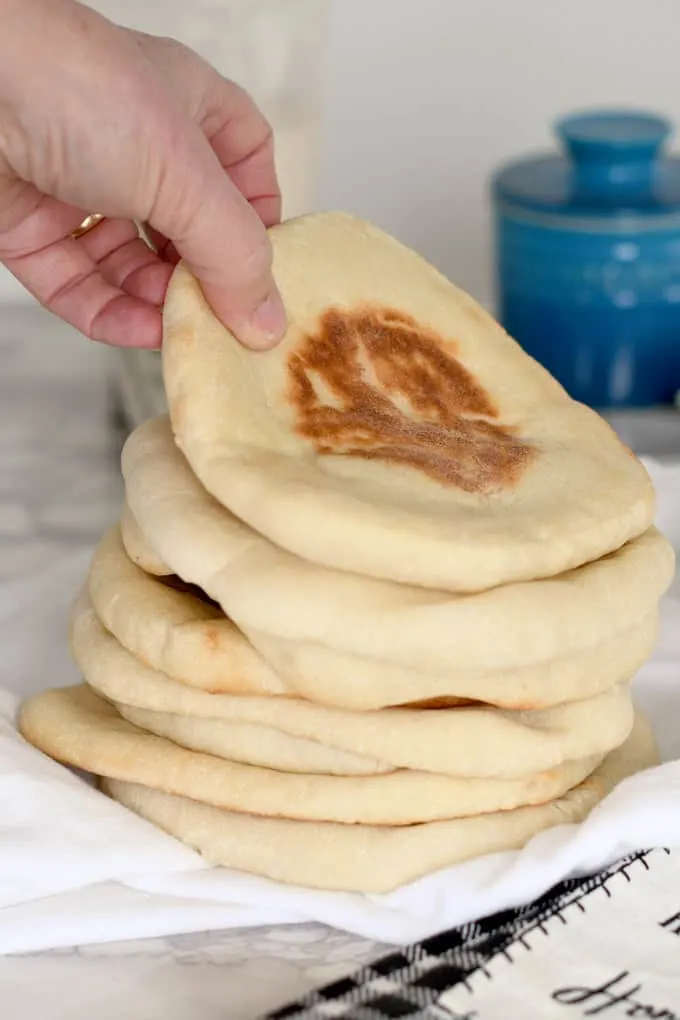
Have you ever made pita bread at home? It’s so much fun to watch the rounds of dough puff up in the oven. I think you’ll be surprised how easy it is to make this delicious bread.
If you don’t already have one, I can show you how to make a sourdough starter and how to feed a sourdough starter. In the meantime you can make Homemade Pita Bread with commercial yeast.
Ingredients for Sourdough Pita Bread
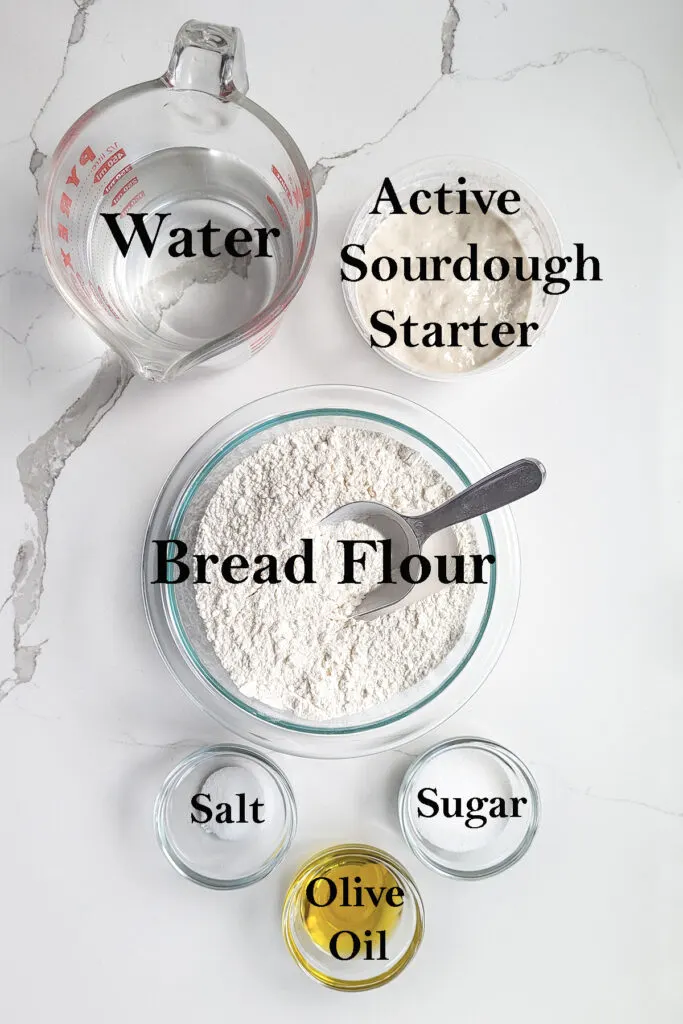
- Active Sourdough Starter – Your starter should be at 100% hydration, recently fed and active.
- Water – Warm water will keep your yeast growning.
- Bread Flour – High protein bread flour will develop enough gluten to allow the pita to puff up in the heat of the oven.
- Salt – For flavor.
- Sugar – For flavor and browning.
- Olive Oil – To enrich the bread and add flavor.
How to make Sourdough Pita Bread:
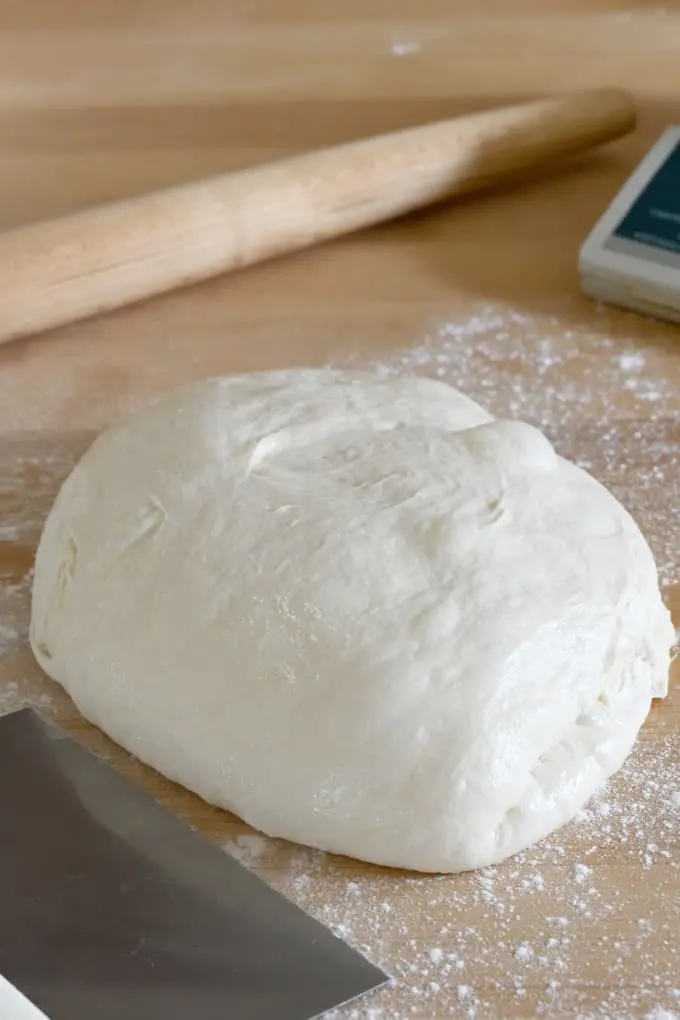
- After a night in the refrigerator, the dough is active and elastic.
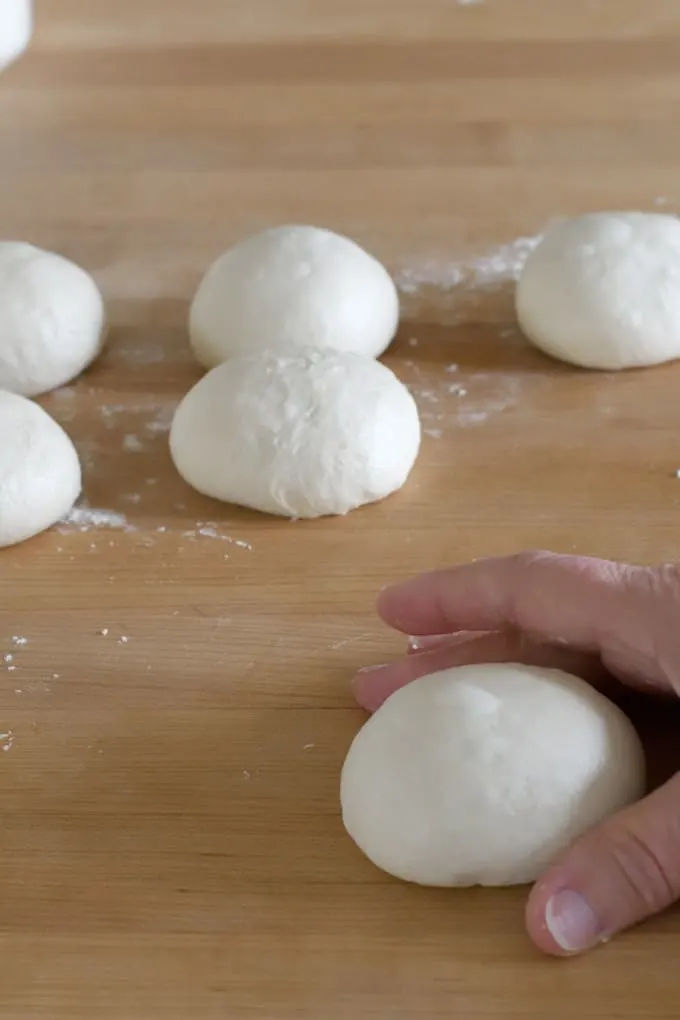
- Divide the dough into 8 pieces and roll each piece into a ball.
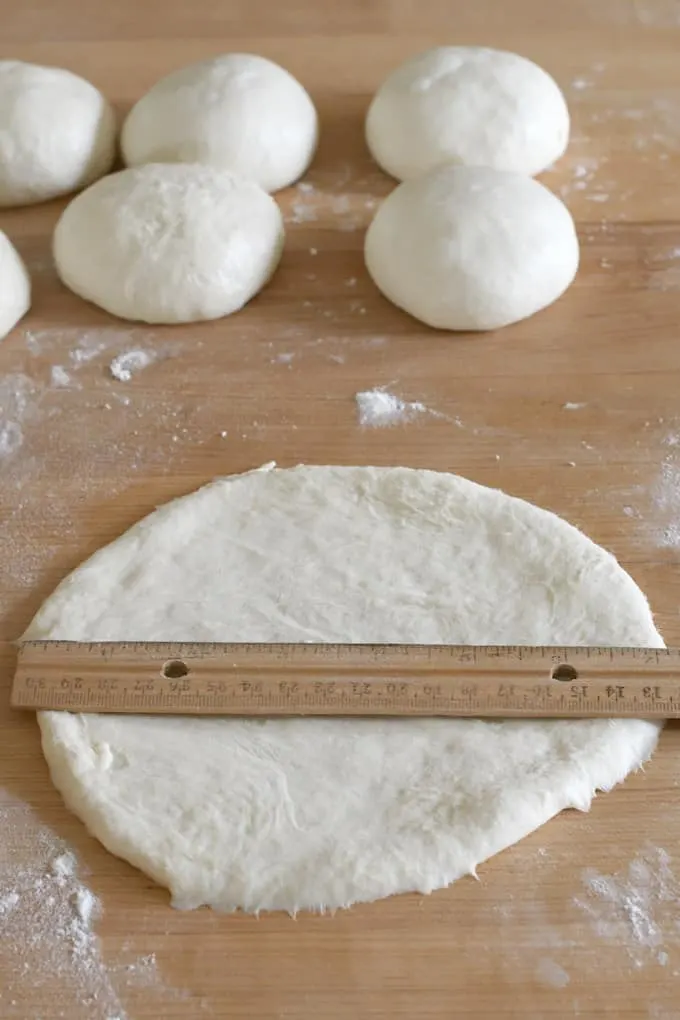
- Roll each ball to a 6-7″ round. If the dough springs back, let it rest and re-roll.
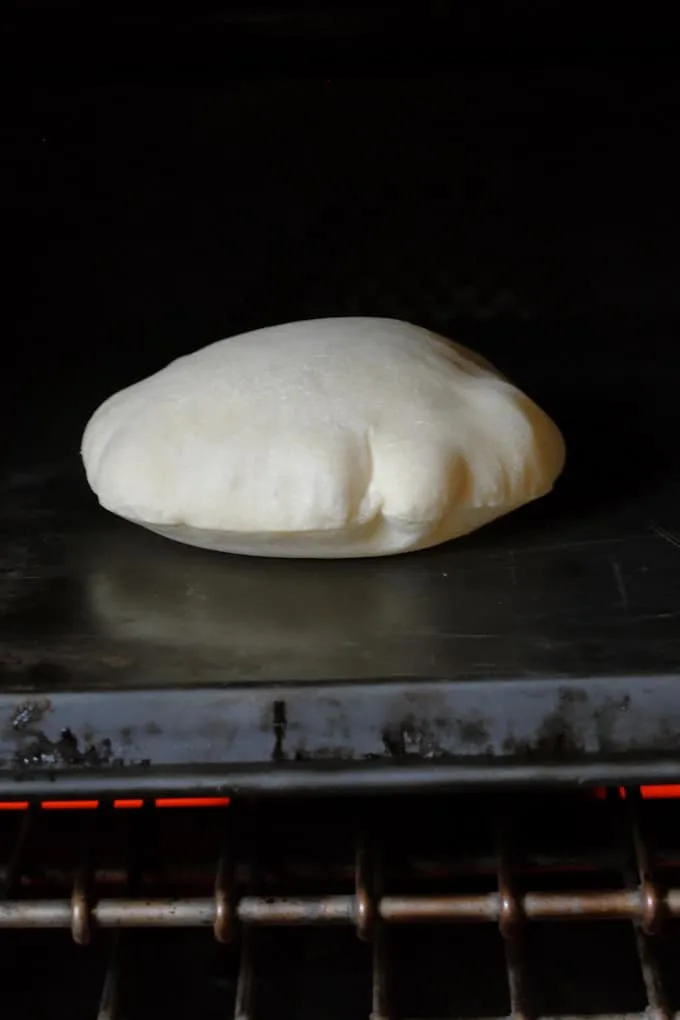
- Bake the pitas on a dark colored pre-heated sheet pan, baking steel or baking stone.
- They’ll puff as they bake.
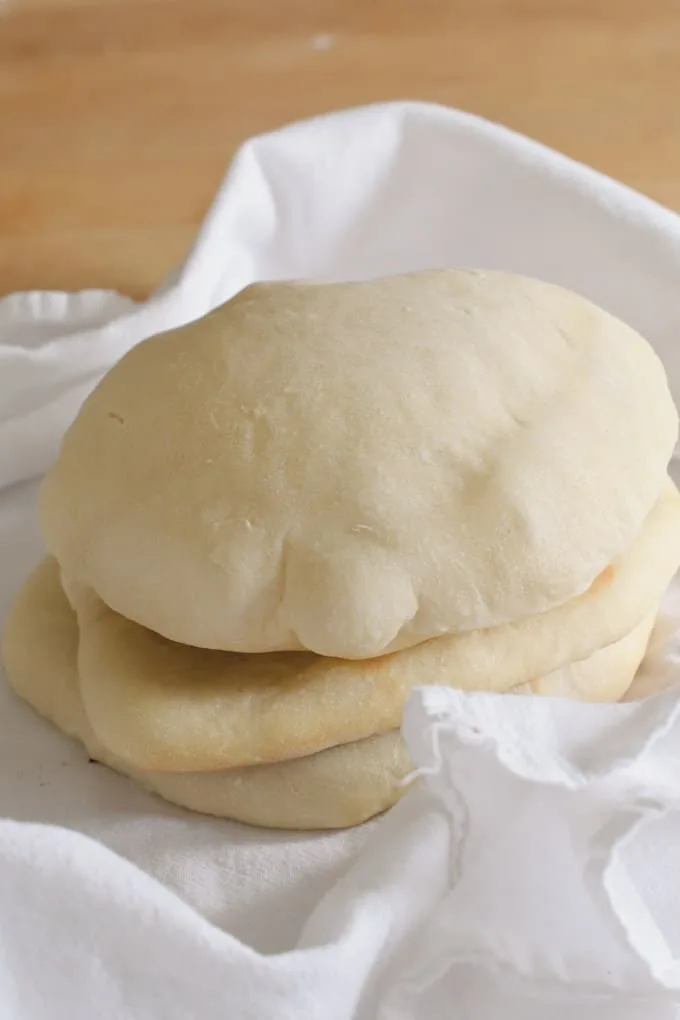
- Wrap the warm pitas in a clean kitchen towel as they come out of the oven.
- They will deflate as they cool.
A timeline for making Sourdough Pita Bread:
- If your starter needs feeding, do that the night before or early in the morning of the day you want to make the dough.
- Mix the dough in the afternoon. Allow it to ferment at room temperature during the day.
- Refrigerate the dough in the evening before going to bed.
- The dough can stay in the refrigerator for 2-3 days at this point.
- Take the dough out first thing in the morning and let it come to room temperature.
- Roll and bake the pita rounds once the dough is at room temperature.
- You should have fresh bread by lunch time.
FAQs about making Sourdough Pita Bread:
Yes, start the dough early in the morning and skip the refrigeration step.
If your oven is not hot enough the pita may not puff properly. If the sheet pan or baking stone is not pre-heated the pitas won’t puff. If the bread is rolled too thin in spots it may not puff properly.
The bread keeps for 1-2 days at room temperature.
Yes! Store the pita rounds in a freezer bag for up to 3 months.
Wrap the pita in foil and place in a 200°F oven until warm.
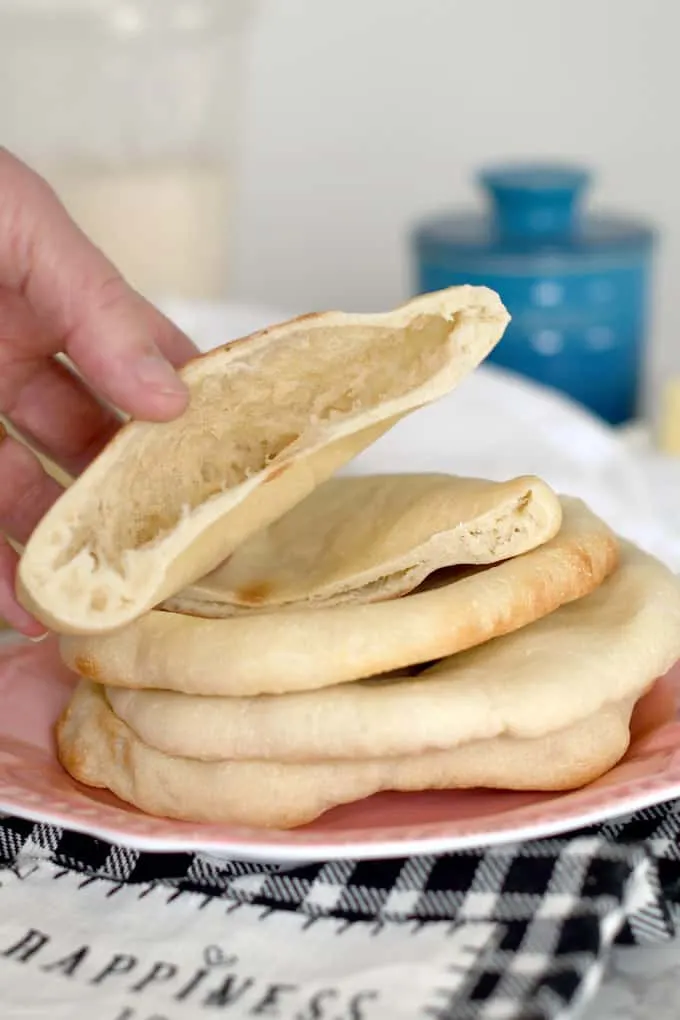
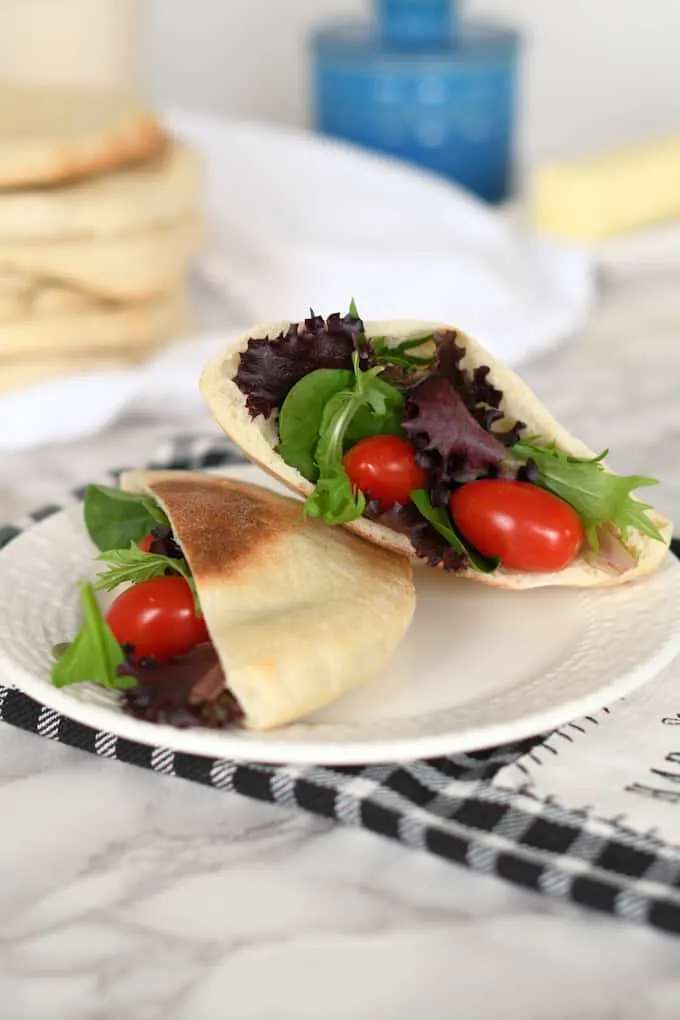
I know you hate to throw away that sourdough discard. Check out these recipes that use sourdough discard.
More recipes to try:
- Sourdough Whole Wheat Pita Bread
- Basic Sourdough Bread
- Sourdough Pizza Crust
- Sourdough Baguette
- Sourdough Soft Sandwich Bread
- Sourdough Rye Bread
- Sourdough Whole Wheat Bread
- Sourdough Cracked Wheat Bread
- Sourdough Potato Buns
- Sourdough Hoagie Rolls
- Sourdough Brioche
- Sourdough Semolina Bread.
If you love this recipe as much as I do, I’d really appreciate a 5-star review.
Sourdough Pita Bread Recipe
Ingredients
- 8 oz active sourdough starter (1 cup (100% hydration))
- 8 oz warm water (1 cup)
- 13 ¾ oz bread flour (2 ¾ cups, see note)
- 1 oz olive oil (2 tablespoons)
- ½ oz granulated sugar (1 tablespoon)
- 1 ½ teaspoons table salt
Instructions
- In the bowl of a stand mixer fitted with a paddle, or in a large mixing bowl, combine 8 oz active sourdough starter, 8 oz warm water and half of the flour. Mix until it forms a thick batter. Cover the bowl and set aside for 30-60 minutes.
- If using a stand mixer, switch to the dough hook. Add 1 oz olive oil, ½ oz granulated sugar and 1 ½ teaspoons table salt then mix to combine. With the mixer running on low, add the remaining flour. Mix until the dough clings to the hook and clears the sides of the bowl. If mixing by hand add flour until you can no longer stir, then turn the dough out onto a floured surface to finish by hand. Knead 5 minutes. Form the dough into a smooth ball.
- Put the dough into a lightly oiled bowl, turning once to coat the dough. Cover the bowl and set it aside at room temperature.
- After 60 minutes uncover the bowl, lift one side of the dough and fold it into the middle of the dough. Repeat with the other three sides of the dough then flip the dough over. You're basically turning the dough inside-out to redistribute the yeast and develop the gluten.
- Every 60 minutes repeat the procedure again. By the end of 3 hours the dough should be lively, elastic and airy. If the dough is still sluggish give it another hour or two at room temperature.
- Cover the bowl tightly and refrigerate overnight (see note). Remove the bowl from the refrigerator in the morning and allow the dough to come to room temperature.
- Preheat the oven to 450 °F. Use the convection setting if you have it. If you have a baking steel or stone place it in the oven. Otherwise, place a baking sheet on the bottom rack of the oven. If you have a dark colored baking sheet use that.
- Divide the dough into 8 equal pieces. Using a cupped hand on a lightly floured surface, roll each piece of dough into a tight ball. Use a rolling pin to roll each ball into about a 6” round. If the dough springs back too much let it rest for 5 minutes and continue rolling. Once all the pitas are rolled you can begin baking.
- Place two pita rounds on the baking steel or pan. Close the oven and bake until the rounds puff up like a balloon, about 3-4 minutes. You don’t need to flip the bread. Remove the baked breads and wrap in a clean kitchen towel while you continue baking the remaining pitas.
- The pitas are best the day they are made, but they also freeze very well.
As an Amazon Associate and member of other affiliate programs, I earn from qualifying purchases.

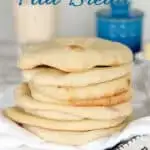
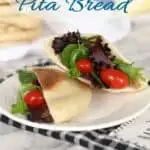
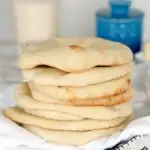





It was so easy and so good. Thanks for sharing the best sourdough pita bread recipe I ever made!
No-fail recipe! I’ve made this twice now and love how easy it is. It takes a bit of time, but the dough is very forgiving. I did 1/2 whole whea-1/3 white flour and enjoyed that even more than the all white flour.
I have been using this pita recipe for roughly a year now (I make pita every 6-8 weeks) and follow the directions precisely and it turns out perfect every time. My family, my friends…. They all tell me it’s the best pita they’ve ever had. Thank you for this straightforward and excellent recipe! Love it!
There is no note that I can find regarding the difference in flour amounts.
13 ¾ oz bread flour (2 ¾ cups (see note))
The note is in the “notes” section at the bottom of the recipe card. There is no difference in flour amounts. The note explains how to measure the flour if you aren’t weighing your ingredients.
I’m quite new to working with sourdough, so I think each new recipe is a learning experience. I started out with six-month-old, dormant starter and had to bring it back to life before I even got to your recipe. I was a bit hesitant to make a recipe that didn’t call for any regular yeast. I found that my resurrected starter rose beautifully and the final product was wonderfully tangy. While this recipe is more time-consuming than my bread-maker sourdough, it was worth the extra time. I did find that the humidity and rainy few days we’ve been having definitely made a difference in the texture of the dough. I really should have added extra flour during the mixing step to stiffen it up a bit. It was very soft and difficult to lay it out neatly on the baking stone. I got some pretty wonky looking pitas. I think because the dough was so soft, I overbaked it because the dough just wasn’t cooking through.
All that said, I am definitely going to try this recipe again, paying more attention to the stiffness of the dough. Mine never did “clean the bottom of the bowl and form a ball around the hook.” Thanks so much for sharing your recipe!
Sounds like you did a great job. Yes, the texture of the dough can vary with weather but I find the biggest factor is the condition of my starter. When a starter is recently fed it has a very different texture than it does just a few hours later when it’s starting to wane. You’ll will “get to know” your starter as you bake with it and get a feeling for when it’s at it’s peak and ready to go. Have fun!
@Eileen Gray, when I mixed the dough it was maybe an hour after the last “feed” was finished. I stashed it in the fridge until I had all the ingredients ready for mixing. So you think had I stashed it a little longer (a day?) I would have had a stiffer dough?
Also, can you speak to the thickness of the rolled-out pitas? My sister said mine were maybe 3/8″ thick rather than 1/4″. How would that have effected the puffing up and length of baking time? Sorry to bug you with all these questions. Happily, you’ve been pretty thorough with your instructions. You can’t believe how much that is appreciated, especially with us beginners.
My starter generally takes 3-4 hours at room temperature to be ready for baking. You want catch the starter when it has risen almost to it’s peak and before it starts to recede. I roll my pitas to about 6-7″ across. They do tend to spring back as you transfer them to the oven so they’ll be a little smaller as you put them in the oven. If you roll the dough too thin the pitas may not rise properly. I still do it myself sometimes where I get a thin spot and the pita doesn’t rise all the way across.
The cups are figured incorrectly. It is 3 1/4 cups total flour not 2 3/4.
Ummm, the cups are not figured incorrectly. You can read through this post on how to measure baking ingredients for an explanation of how to convert volume and weight measures. But if you have a scale it’s always best to weigh your ingredients.
Would a baking stone work rather than a steel or inverted sheet pan?
Yes, if you get it hot enough. You want lots of bottom heat to bake the bottom of the pita and allow the top to rise.
Hi! The recipe calls for 13 3/4 oz of flour – and step 1 calls for using all 13 3/4 oz of it. I’m confused as step 2 states to add the remaining flour but there was no remaining flour to use?
Please help! Thanks!
Step one has you add 1 1/2 cups of flour (7.5oz). The gray text is showing you the full ingredient list. I can remove the extra text.
Excellent recipe and it was much easier to follow than other sourdough recipes I’ve tried.
Great recipe and instructions. My dough was a tad sticky but a light coating of EVOO on my rolling pin and dough ball did the trick. I really enjoyed making these and plan to do so again!
Delicious! My first 2 didn’t puff much because I didn’t roll them out to the full 6″ round. Once I fixed that, the rest were delightful to look at and eat!
Sooo sticky the dough – how to shape the pitas without having to add lots of flour??
I make this bread every week and if I start with a nicely active and well fed starter the dough is beautiful after the fermentation. Is your starter 100% hydration? Are you using weight or volume measures?
@Eileen Gray, It is aimed to be – I do by weight, but it could be off to start I suppose. The starter is nicely active. Should I just add more flour until it is not so sticky?
Does it get less sticky after the fermentation period? Often a dough that is quite sticky develops nicely as it ferments. I would avoid adding too much flour as then the bread can be heavy. Another option is to refrigerate the dough overnight and roll with cold dough in the morning. The cold dough is a little easier to handle.
Another great recipe! I’d never made pita pockets and was amazed at how they puffed up. We made them right before lunch and had a fresh pocket. So divine!
Very new to sourdough baking.
I was worried about this because I kept it out on the bench overnight (coming out of winter here and fermentation takes much longer) and when I saw it this morning it felt so soft and squishy.
I was worried it had over fermented. But I did some more research and learnt that pita dough is much more hydrated than regular bread dough and I decided to keep going with it as normal and it was a great success!!!
I used an inverted cast iron skillet as a baking stone and it worked so well. They’re so tasty too!
I will forever be using this recipe for pita bread.
Thank you!
Thanks, this is one of my recipes that I make constantly. I make a batch and keep them in the freezer.
Successful! Love this bread! I made it on the same day, and the results were so very good. I love finding new ways to use the sourdough starter mt daughter made during the pandemic. It was Easter evening of 2020 when the yeast was ready and she made her first sourdough loaf! She posted a picture of it, went to bed, and had a heart attack. She died the next morning. That has now been 25 months ago, and using this starter in various breads has been a joy and comfort to me. This batch — my first — was my learning one. I will make it again in two weeks as part of a house church celebration of Pentecost.
Oh, my. I’m so sorry for your loss. I know it’s a small thing, but how nice to have that starter as a connection to your beloved daughter.
Simple, delicious and successfully puffed into pockets with same day baking!
I started the autolyse at about 9a and forgot to add the other part of the flour, sugar (subbed honey) and salt until closer to 11a. The bowl was near a crock pot during that time, so it actually started bubbling nicely… followed the recipe from then on with the stretch and folds, etc.
I “make” bread flour from AP flour by subbing 1.5tsp of vital wheat gluten per cup of flour (ie. Bob’s Red Mill). So far, it’s worked beautifully to bump the gluten content in bread and now pita. A much more cost effective way for me to have organic bread flour!
I don’t know what I did wrong, I used 1 cup Einkhorn whole wheat flour and 1 3/4 cup bread flour dough seemed ok the first day…I left it in the fridge on Monday night and Tuesday night and Wednesday took it out around 4 pm and let it come to room temp it was sticky couldn’t roll it out no matter how hard I tried it was a sticky mess.
It’s possible it over fermented. Changing out the type of flour will change the outcome. Do you still have the dough? You could try adding more flour to feed the yeast and see how it works out.
When baking the pitas on the baking stone, do I do them one at a time? Looking forward to making these in the morning!
I can fit 2 at a time on my stone and on the heavy black pan that I also use to bake pitas. You can bake as many as you can fit without them touching.
Thanks for recipe. I used the same ingredients, except I halved the starter. From mixing to pulling it out of the oven it took nearly 7 hours. I didn’t do the overnight in the fridge. 5-6 mins in a cast iron pan. Came out great!
@Bryan,
When using a cast iron skillet, are you cooking at medium/high heat. I have an electric stove.
close to perfect/ the center was not done at 8 min, but I bake at 6500 feet. Im trying increase oven temperature to 475 and increasing flour by 2 tbsp and starter by 1/4 cup/we’ll see.
BJM
@Bruce MacKinnon,
I’m at about the same altitude. Do you have any favorite high altitude recipes or tips? Thanks!
I made this recently & it was stellar! Worked exactly as directions indicated & made beautiful pitas with perfect pockets. I did a batch & a half as I needed a dozen pitas & it was no problem. Added my home ground whole wheat in the proportions recommended & still had lovely fluffy breads with that sourdough flavor & whole grain goodness. Doesn’t get much better than that!
I have tried so many recipes for pita bread this one is the best by far, I was able to make it with whole wheat flour. When rolling each bread, I used grain bran instead of flour it was superb and very healthy. Thank you
These are so delicious, wonderful taste and texture! I’ve had fresh sourdough bread, even pancakes, but this is my favourite.
I found the cooking time to be closer to 10 minutes. I just kept checking every couple of minutes until some nice browning happened.
I really love this recipe, but I’ve been having issues with the dough sticking badly to the counter when rolling it. When I try to pick it up, it stretches and rips, and becomes too thin to puff up.
I’ve made the recipe 4 times, and the first 2 times it didn’t happen. The only difference is that I’ve been letting it stay in the fridge for longer (16+ hours), and letting it fully come to room temperature before rolling. The first 2 times I was impatient and the dough was still cool when rolling. All 4 times I’ve weighed ingredients, and am always using peak starter that I fed with a mixture of wheat and AP flour beforehand.
This last time, I rolled the pitas directly on parchment paper, and transferred the whole thing to my baking sheet. This worked great, they puffed beautifully, but did not brown on the bottom. Still tasted good though, very fluffy and cooked through. I figured out that if I scooted them off of the parchment paper after they puffed, about 3-3:30 mins into cooking (since I’m using a baking sheet and not a stone, they usually take closer to 6 mins to fully cook), then I still got the browning effect.
Does anyone have advice for me? Am I just letting it ferment in the fridge too long? This recipe is also the first time I’ve used my rolling pin, so I might be missing some rolling-common-sense.
The dough is easier to handle when it’s a little cool. Also a longer fermentation will change the texture of the dough. When I’ve had this dough get very sticky on me I just use plenty of flour when rolling. Flour your hands, the table and the rolling pin.
@Emma, the stickiness is from your dough hydration. My guess is that your AP flour has a lower gluten content than the bread flour called for in the recipe. Keep in mind that you should reduce the amount of water by 2% (gluten absorbs 1.9x) for every 1% reduction in the protein content of your flour. AP flour generally has about 2% lower protein content than bread flour, so I’d reduce the water content by 7g when using all purpose flour.
Which bring me to the small error in the recipe. It says 240 ml water, while it should say 224 ml. Water is approximated to have the density of 1 at room temperature. So measure out 224g and you should get the ~68% hydration the author was shooting for.
Finally, try cooking the pitas on the stove top – I’ve found that using a heavy cast iron skillet works best. You get a very good brown crust. And you can let the dough stay in the fridge for up to 3 days, so retarding time is probably not the issue.
Loved this recipe. I was able to take out half the dough and make pitas one day leaving the rest of the dough in the fridge for another day. Once I used enough flour to roll them out they were easily handled. We did a pita smorgasbord with tuna fish, hummus and peanut butter and jelly as the choices. So good.
@jen price, what a suprising and excelent idea to make pitas a bit at a time and keep the dough in the fridge. Will try that since i have my dough fermenting right now
Hi, my dough is very very wet and sticky! any ideas on how to resolve the issue? (this is before refrigerating overnight)
The dough will be easier to handle after fermentation and refrigeration. If your starter is not 100% hydration that could alter the outcome of the recipe. Weighing your ingredients will give more consistent results. Also, use your starter when it is at or just past the peak activity. An older/riper starter tends to make a stickier and less cohesive dough.
@Lindsay Adams, mine was really sticky too, I added extra flour until it was pliable and it turned out perfect!
Not really sure what I did wrong but I tried to use whole wheat flour but didn’t quite understand the note of the 1 cup replacement. I used the same amount that was required of bread flour but my dough was waaaaaay to wet and did not poof up when cooked. They were still raw on the inside:( was so excited to try this but I’m a little sad it didn’t work for me. Any suggestions?
To make whole wheat pita bread instead of using 2 3/4 cups of bread flour in the recipe, use 1 3/4 cups bread flour plus 1 cup of whole wheat flour.
I’ve made pita bread in the past using different recipes. Came across yours and this one was the most superior one. Clear and easy recipe to follow and they all puffed up beautifully!
My husband said that these pitas were the best he’s ever had! Making them again next week for my birthday. Thank you so much for sharing this lovely recipe.
Astounded!!! I never thought pita bread would be able to impress me! What a trustworthy recipe! No tricks! Used type 0 flour and left in the refrigerator for just under 24 hours. Fabulous results, puffy, delicious, great texture.
Hi! I have made this recipe a handful of times now and always got delicious, flavorful putted pitas, thank you so much!
I do have one question tho, the pitas in your photo appear grilled, while mine come out completely white. They are baked through but have no colour. I tried getting my oven 10 degrees hotter, leaving the pita in the oven for longer, and even, out of desperation, pan frying the baked pita in olive oil. None of there added the coloration I was after. Is there something I should know?
I bake on a preheated pizza stone.
Thank you!
Many thanks for the recipe. It produced one of the smoothest dough I have ever made. Three out of the eight pitas puffed up fully. For the rest, the center were flat while the edges puffed up. I wonder why as I shaped them quite consistently. I baked them two at a time. In some cases, one puffed up fully but the other did not. Anyway, they all taste good and flavorful.
Usually, they will fail to puff if spots are rolled too thin.
Hello, my pitas came out of the oven very flat and hard. Any suggestions on what I am doing wrong?
Most likely if they didn’t puff you rolled them too thin. They could be hard because they’re too thin and perhaps baked too long.
Hi. I am so excited to try this recipe. I read the notes, but if I want to make these the same day, is there a second rise? OR do I simply shape and bake after the 4-6 stretch and folds? Thank you!
No need for a second rise. After the fermentation period go ahead and divide the dough and roll the pitas.
for all the people confused about the weight of water, it is VERY simple. One ml of water weighs one gram. 200ml of water is 200g. there is no need to convert back and forth. this is not the same with oil as it has a different density, but for water it is 100% correct.
This recipe was perfect. I made it without the Dough Improver and it didn’t make a difference. I used my bread maker to make the dough. They came out perfect! I can’t wait to make these again.
Great recipe! SO much better than others I’ve tried. Thank you!
Worked brilliantly, but just did my own thing loosely based on the recipe.
New to sourdough baking, I’ve made this recipe twice a month since the pandemic started…When the temperature has been cold, hot or warm. With all purpose wheat and white flour or 100% all purpose white flour. Using the second rise in the refrigerator step or skipping it. The outcome has been perfect.
Every. Single. Time. Thank you so much!
For what it’s worth, I was mixing this dough and getting an un-kneadable shaggy mass, then I remembered that I was using all-purpose flour instead of bread flour. I have used AP flour in another recipe that called for bread, but I had to reduce the water by about 1/6th, because bread flour tends to absorb more water and AP doesn’t.
So if you’re getting a very wet dough, it might be the flour as well as your idea about the starter.
I’ve used this recipe twice so far and I got dough that was way too wet both times, using the exact measurements provided. I added flour with good results, but it was bothering me that I didn’t have the success that others did with the original recipe, especially since the hydration percentage is fairly reasonable.
After some thought, my best guess is that because the starter is such a significant portion of the dough, the variability is occurring there. Even if the starter hydration is 100% consistently, I think it’s possible that my starter (fed ~10 hours ago) has almost entirely fermented the flour, and therefore it doesn’t add any structural capability to the dough while still adding wetness. I know my feeding schedule may not be best practice, but it may explain the trouble that others are having as well.
Take this with a teaspoon and a half of salt, it’s just a thought from a ‘very’ amateur baker.
Hi Greg, I agree with you that the hydration and activity of the starter can have a great impact on the dough. I notice with my starter that it is quite thick when I feed it and thins out as it ferments. Sometimes after a week or two the discard is the texture of heavy cream. For best results I recommend using the starter when it has just about doubled in volume after a recent feeding but is still very active.
Greg and Eileen, I have the same problem. I’ve made this recipe twice now, the first time I measured with cups, tsp, tbsp, etc. I’m currently making the second try and weighed all the ingredients and it never shaped into any of the “balls” necessary, just loose blobs, and I can’t move it from rolling it out (stuck to the pin, the mat, the scraper) to the hot stone, it just melts into a messy blob. Not sure what’s wrong. It bubbled up in the fridge quite well. Starter seems happy and is fed at least once a week, kept in the fridge between feedings. I’m pretty frustrated at this point.
I was gifted some starter from a friend in the beginning of quarantine and after trying many many recipes I have now realized that all of the ones I love and repeat are yours. Thank you for making my quarantine that much better!!!
Thanks!
I normally measure my sourdough bread recipe ingredients with a scale by weight, however most scales don’t weigh ml since that’s a volume. I added the wrong amount of water since it is shown in ml. It may be helpful to write it in grams instead. I’ve noticed that’s how all just about all bread recipes are….
I see what you’re saying. I tend to measure my wet ingredients in a measuring cup which is why I use ml. Maybe I’ll start adding grams as well.
All the ingredients you show are listed in grams except water :/
Yes, as noted in my response to your original comment. I scoop flour directly into the bowl on the scale, but since the water is put into a measuring cup to pour, I use the ml measurement. For future reference, the conversion from oz to grams is 28g per ounce.
I also wanted to add that we didn’t make them all at once – we refrigerated some of them after the first rollout, then rolled and baked them straight from the fridge the next day and they were just as good.
This recipe was perfect.
I made these for the first time today. Some puffed and some didn’t, but I blame that on my rolling skills..lol
Thank you for sharing this recipe with us!
I find sometimes I get a dud that doesn’t puff when I roll the pita too thin or if the pan I’m baking on is not quite hot enough.
This recipe was perfect. I made it without the Dough Improver and it didn’t make a difference. I used my bread maker to make the dough. They came out perfect! I can’t wait to make these again.
Didn’t come out well at all
Do you have any questions?
I’ve been wanting to make this for a while. It was outstanding and I will be making it again and again as well as sharing it with my friends. Very good and super easy to do. I can’t believe it was done in 5 minutes in the oven.
Sherry in Fairbanks, Alaska
Amounts are off, technique is off, this was one soggy, sticky, wet mess of a dough. See my full review for modifications I made. This recipe needs to be redone. I find it suspicious that that are so many 5 star anonymous ratings with no comments. This is not a well done recipe.
Are you accusing me of planting false reviews on my site? I can assure you that every one of the “suspicious” 5 star ratings are legitimate reviews from readers. I welcome all comments and reviews on my recipes and would never plant false reviews.
I read and respond to every comment and question from readers. I have often made adjustments and clarifications to my recipes based on user comments and reviews. Since I personally make a batch of this pita bread almost every week, I can assure you this is a viable recipe that has been tested and retested.
I read through your review of this recipe and have a few clarifications to make. You note that you are always looking for ways to use your sourdough discard. This recipe calls for “active” sourdough starter. The first step in the timeline instructs the reader to feed the starter the night before or early in the day the dough will be mixed. In reference to the sponge step you say “This is not enough time to allow the starter to feed on the new flour and water you’ve added.” The sponge step is not to “feed on the new flour” since the starter should be fed, active and bubbling before you mix the dough. The 30-60 minute sponge step is to hydrate the flour and give the gluten formation a head start.
The recipe as written is 68% hydration which is not super wet for a sourdough. If you added 1.5 cups of flour in addition to the amount listed in the recipe your dough would be about 47% hydration, which would be quite stiff.
Regarding bulk fermentation you note that in order to correct to the recipe you “put it in the fridge overnight, which is the classic sourdough bread method. This also helps add a little more of that classic sourdough tang to the pita”. Step 6 of the recipe says to “Cover the bowl tightly and refrigerate overnight” so I’m not sure how this was a correction to the recipe.
You say, “The bulk fermentation (step 2) is instructed to be done in the fridge”. Actually, the recipe has you do steps 3-5 of the bulk fermentation at room temperature for 4-5 hours and then put the dough in the refrigerator for the night to get that “classic sourdough tang”.
I appreciate your detailed reply to Colleen’s recipe review. I’m often appalled by the extent of rudeness and know-it-allness in recipe comments sections. Someone who clearly sees themselves as a baking expert should know the first thing to check on a sourdough recipe is whether it uses active starter or discard. I commend your patience with these people!
Another great recipe from this site! Thank you so much!
Finally! A pita recipe that works! I measured each ball and it came out to around 118 (+/-) grams per. Have you found this to be true? Or is my dough that dense? Yikes! At any rate, the flavor is superb and I achieved the puffiness expected. Thank you!
I can’t remember the exact weight, but I do weigh out the balls of dough. I like them to all be the same size.
I made each of my dough balls 4 oz came out nicely as an israeli my pita standerds are higher then most and these turned out great
Hello Eileen, I made your sourdough pita recipe and it tastes delicious. I got a pocket but the pocket has a very thin top. Is there something I can do to achieve a more even pocket? I did not roll the pitas out to 7-8 inches because that would have resulted in rolling out to 1/8th of an inch rather than 1/4″ as the recipe suggests. Perhaps that was my challenge. Thank you for sharing so many lovely recipes.
I find I get the best pocket when the pan is very, very hot before I start baking. I’ve been impatient and tried to start baking before the pan was preheated and I got uneven pockets.
Could you refrigerate the dough for multiple night? I want to serve my family pita in a couple days, but I plan to make the dough tonight and then go out of town.
You could refrigerate for up to 2 nights. After that I think the yeast might need a feeding.
Hello,
I was wondering what the reason is for the addition of sugar in this recipe? is it also possible to omit the sugar?
Kind Regards,
Iris
The sugar is there for flavor, for tenderizing and to promote browning. You can leave it out but the texture will be slightly different. May I ask why you want to omit the sugar? It is only 1 tablespoon divided by 8 breads.
Hi Eileen,
thank you for the quick reply. 1 tablespoon divided by 8 is indeed not much, I had not thought about in that way… I usually try to prevent the addition of sugar in recipes as much as possible (I’m really not a sweet tooth (if that’s the correct expression)). But if it affects flavor and texture, I’ll add the sugar in this case (they look so good on the photo’s)!
Yes, sugar does more than just sweeten a recipe. Have fun!
Any suggestions on how to get a rounder shape? My dough was so sticky that I had trouble rolling it out and the pocket didn’t really poof up.
Use plenty of flour for rolling as it is a sticky dough. To get a round shape roll from the center out in all directions. If you roll the dough too thin, or if the pan and/or the oven isn’t hot enough you will not get a good pocket on the bread.
In step #8 you say to “roll two pitas to 1/4 thick” but I don’t see photos or any other mention of using two dough balls for each actual pita. Can you elaborate? Thanks
I mean that you should work with two pitas at a time. I find it easiest to work with two pieces of dough at the same time because I can fit two rounds on the pan in my oven.
These turned out beautiful! I did a triple batch for my family of six for gyros for supper, intending on trying to make pita chips with one batch worth. They may not make it to becoming chips! It was kind of a long process doing so many, but it was fun because it became a family project.
I am loving discovering how much you can do with sour dough starter!! I want to try English muffins next!
My starter (rye) usually only gets fed about 45g each flour and water every day unless i’m storing it in the fridge. Would you instead recommend feeding it 110g each to get that 224 grams (1/2C) for the recipe? Usually, if I’m baking bread, I’ll pull a small bit from my sourdough and make a levain in a separate container. But maybe ill just increase the volume of the starter the night before instead.
You could do it either way. I write my recipes using my method, but if you want to pull a bit of starter and make a levain that would work as well. As long as you get to 8oz/224g of active starter for the recipe it should work.
Hi Eileen! Thank you for this recipe – I’ve made it twice, now, with great results, but I always seem to need to add a good amount of flour to change the dough from a sticky mess to a proper sticky dough ball, and I have a couple of questions:
The weights for water and flour you’ve listed are different than I’d normally expect – usually bread flour is 120g/cup and water is 250g/c. The total grams of flour/water above would be 3 1/8 c bread flour/250g water – when you make the recipe, are you using the grams or cup measurements for these?
Using weight measure will always give the best results since the way you measure a cup of flour can yield different weights of flour. I use the “dip and sweep” method for measuring flour. That is, dip the cup into the bin to overfill then sweep away the excess. If you use the method where you spoon the flour into the cup you will have less flour by weight in one cup. Using the dip and sweep method I get 5 oz per cup of bread flour and it is the measure I use for all my recipes. I use the conversion of 28g per oz which means a cup of bread flour is 140g (5oz x 28g). 2 3/4 cups of flour in the recipe weighs 13.75 oz or 385g. For liquid ingredients I use the conversion of 30 ml per liquid oz. So 8 liquid oz of water is 240ml. If you want to weigh the water it would be 224g.
@Eileen Gray, I’m excited to try this recipe! I am confused about the amount of water, though. In your response above you say that the water should be 240 ml or 224 g, but 1 ml water = 1 g water. Not sure whether to use 224 or 240 g. Thanks!
A.M.A.Z.I.N.G, I love this recipe, the pitta breads are delicious. I will never buy pitta breads from the shops ever again!! Thank you for sharing x
Thank you so much for this recipe! I was so sad at the thought of wasting flour at this time when it’s hard to find so I’ve vowed to use all my sourdough starter discard creatively. Turned out lovely, we had turkey stuffed pitas for lunch today!
You’re welcome!
I did the wheat flour substitution at the bottom of the recipe. I used sourdough discard. These came out great! Don’t roll them out too thin, or they won’t balloon up in the middle. I found they needed about 6 minutes at 450 degrees F. Thanks for the recipe!
Would it be possible to use cast iron pan instead of baking in the oven?
I can’t say for sure because I haven’t tried it, but it could work. Although in the oven you also get the radiant heat over the tops of the bread. If the oven is just not an option, I think it’s worth giving it a try.
thanks!!
I bake these in the oven with the cast iron inside. It works perfectly!
Good to know.
Why not bake in a cast iron pan in the oven? Probably I’m wrong and you don’t have a lack of baking sheets, but rather a lack of oven. A lid might be nice then.
Yes, that would work too. Any heavy, dark colored pan would do the job. The more surface area, the better, so you can bake a couple of pitas at once.
Absolutely!! I use 2 cast iron skillets and they work perfectly!! This is a great recipe and method, BTW!! Thanks!!
5 Stars*****My sourdough starter was very active so I took a chance and made this all in one day, skipping the refrigeration step. I had never made pita bread before and it turned out great! Thank you 🙂
You’re welcome!
Thank you…tried this with my discard.
Came out so nice
Turned out great!! Thank you so much. Dough was sticky so extra in rolling out but favor was wonderful and perfect puff for pita bread.
Glad you liked them! This dough is a little sticky, but that means the bread is nice and moist.
Having difficulty finding bread flour. How much wheat or AP flour can be substituted and still have the recipe work?
Luckily I was gifted a 5# bag of bread flour by a friend. The stuff is hard to come by right now. I would start with the same amount of flour listed in the recipe. Because bread flour absorbs a little more water than ap flour, you might find that the dough is a little sticky. Sprinkle in a little extra flour if you’re finding the dough too hard to handle. But the dough will become more cohesive and less sticky as it ferments. So I would error on the side of leaving it a little more sticky and see how it develops. You can always sprinkle in a little more flour as needed.
Thanks for the recipe. I’m so excited to try it!
To make this recipe with whole wheat do we do:
1 3/4 bread flour and 1 cup whole wheat?
or just 1 cup whole wheat without any bread flour?
I think using 1 cup whole wheat and 1 3/4 cups bread flour should work well.
I’ve used this pita bread recipe twice now and it has worked perfectly. So good!
That’s great. Thanks for the feedback.